January 18,
2000 Yukon/Northern BC Fireball
(The Tagish Lake Meteorite)
Links to Fireball News Items:
31-May-2000: University of Calgary and University of Western Ontario-Press Release
17-March-2000: NASA Scientists Study Pristine Yukon Meteorite
16-March-2000: Yukon Meteorite Recovered
3-June-2000 A Location Map of over 500 Meteorite Fragments Recovered on Tagish Lake!
3-June-2000 A Photograph of a Meteorite Fragment on the Ice Cover of Tagish Lake, University of Calgary
15-April-2000 A Description of Fireball by Joe Clarke, Marsh Lake, Yukon
8-April-2000 - A detailed personal account of the fireball by Lorraine Bretlyn
18-March-2000 - See drawing by Brian Beck at the bottom of this page
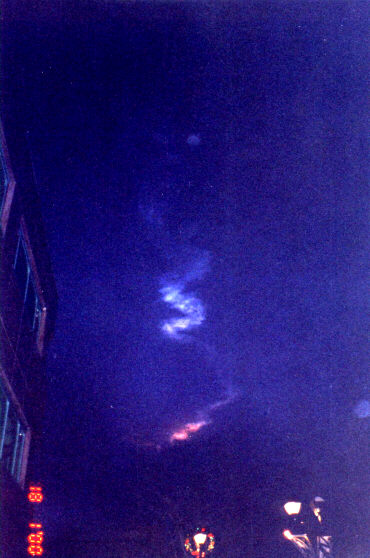
Updated article
April 8, 2000
FIREBALL STREAKS
ACROSS SOUTHERN YUKON SKY,
Fragments Recovered !
January 18, 2000, 8:45am
by Martin Jasek
![]()
Hundreds of Whitehorse residents and witnesses from surrounding communities witnessed a bright series of flashes with many seeing a rapidly moving bright object traveling over the city in a southbound direction where the object was seen to "blow-up" or explode over the southern horizon. The flashes were as bright as daylight and lit up the entire dark morning sky. The object left a contrail that lingered for 10 to 15 minutes after the event (see photos taken by Martin Jasek, right and below, and Doug Davidge below). The contrail was being beautifully illuminated by the rising sun, which was not to rise in Whitehorse until 9:48 am, another hour later. This would indicate that the object was very high up when over Whitehorse but descended rapidly as it traveled south. This is shown by the color variation of the contrail as it is white near the top (in bright sunlight) orange further to the south (passing through rising orange morning light) and then no contrail at all, due to the meteorite trajectory going behind the earth's shadow. The photograph to the right was taken looking south on 4th Avenue adjacent to the Elijah Smith Building (on left).
The Fireball was observed from a very large geographical area. To the authors knowledge, the fireball was witnessed from the following communities: Beaver Creek, Haines Junction, Pelly Crossing, Ross River, Carmacks, Lake Laberge, Whitehorse, Marsh Lake, Teslin, and Watson Lake, Yukon, Atlin, BC, Skagway, Alaska and Norman Wells, NWT. This indicates that the trajectory came in from a high altitude making the meteor visible from long distances.
The light was indeed very bright; one observer saw the meteor streaking by and a daylight sensor on a nearby streetlight caused the street light to turn off. Many described the color of the light as that from an arc welder. The intensity of the light varied probably due to the meteor coming apart. Each time a large piece would brake off, new material was exposed presenting greater surface area for burn-up. Some witnesses observed smaller fragments within the tail of the main object.
Witnesses in Whitehorse and other communities heard a sonic boom a few minutes after the light show. Seismic information from Geological Survey of Canada indicated that a possible impact or a ground concussion from the sonic boom might have been registered in the Carcross Area. Indeed, witnesses in that community heard a very load explosion that caused snow to slide off some roofs.
Everybody was in agreement that the memory would stay with him or her forever. One person remarked "I knew this was probably a meteor, and I only saw it for a few seconds, but I can now imagine how somebody viewing a UFO for several minutes must feel!" Author of "UFO Stories from the Yukon" Lorraine Bretlyn happened to be one of the witnesses. Lorraine writes, "A deep sense of satisfaction, peace and timelessness came over me. And I felt very lucky, indeed. What a fabulous intro into the new millennium" By contrast some were frightened and thought that they were witnessing a replay of Hiroshima.
Some witnesses located south of Whitehorse observed several pieces of debris traveling in various directions after the explosion. The terminal explosion of the meteor occurred 25 kilometres above ground as determined by military defence satellites. This suggests that there may be many fragments distributed over a very large area. Most of this area lies just on the south side of the Yukon-BC Border between Tushi Lake (pronounced "too-shy") and Atlin, BC.
An aerial search showed no sign of an obvious impact crater or craters. However, about two weeks later, an individual who wishes to remain anonymous recovered a portion of the debris. The exact location remains undisclosed. The person came across several fragments of the meteorite weighing about 1 kilogram, placed them in a plastic bag, and kept them frozen. Later he notified Charlie Roots of the Geological Survey of Canada in Whitehorse, Yukon. Arrangements were made for the finder along with the meteoritic fragments to be flown to NASA - Johnson Space Center in Houston, Texas. Analysis showed that it was a rare carbonaceous chondrite meteorite. It is one of the oldest materials in our solar system and contains organics (the building blocks of life). The fact that it was kept frozen and recovered so soon after it fell may have preserved volatile gases within the meteorite thus making it scientifically priceless, indicated Dr. Michael Zolensky, a cosmic mineralogist at NASA's Johnson Space Center (JSC) in Houston. Analysis of the 4.5 billion-year old meteoritic fragments continues.
What increases the value of any meteorite find is determining from where the meteorite came from. If the orbit of the meteorite prior to it entering earth's gravitational pull can be determined the value of the meteorite would be similar to the value of sending a mission to an asteroid and returning a sample back to earth. Enter Dr. Peter Brown, member of the Canadian Meteor Impact board and a professor of University of Western Ontario. Dr. Brown spends a good part of his career back calculating the orbits of recovered meteorites. In February, Dr. Brown visited the southern Yukon and Northern, BC for 10 days scouring the land for witnesses to the fireball and photos and videotape of the contrail. He obtained over 100 photo and video images, interviewed hundreds of witnesses obtaining elevation angle and compass headings based on these sources. (If only UFO investigators could have access to such resources) The author had the privilege of meeting with Dr. Brown and assisted him with the collection of trajectory information. Although Dr. Brown was collecting IFO (identified flying object) data, the techniques that he employed are very useful for investigating UFO sightings as well. The experienced gained by the author is well appreciated.
Other than the sonic boom, which followed about 3 minutes after the event, there was also another sound associated with the fireball. Some witnesses heard a "crackling sound" at the same time they were observing the meteor. This is interesting as this implies that this sound was traveling at the speed of light. This phenomenon is what is called "electrically induced sound". The theory goes something like this; electromagnetic energy produced by the meteor induces static electricity in objects on the ground be it power lines, a persons glasses, their hair, certain types of clothing perhaps. As this static electricity is discharging it produces audible sounds that are picked up by the human ear. It is interesting to note that about 1 in 10 people hear this sound. Even if the witnesses are standing together at the time of observation, one will hear this "crackling sound" while others do not.
Coincidentally, in January and February the Yukon and Northern BC had their share of fireballs. On Jan 11th witnesses near Atlin BC observed a fireball at four in the morning that also created a sonic boom and shook their cabin. On Feb 14th, 2000 two witnesses in Elsa, Yukon reported a bright slowly moving fireball(s). See description on the Sightings 2000 Page.
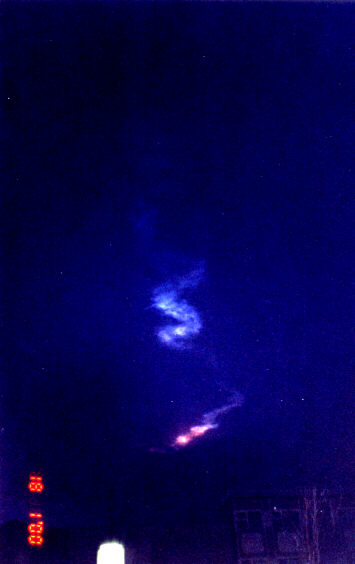
Above: 2nd photo by MJ taken looking across Main Street next to 4th Avenue
Below: Video still by Doug Davidge, Environment Canada taken near Alaska Highway and Hamilton Boulevard
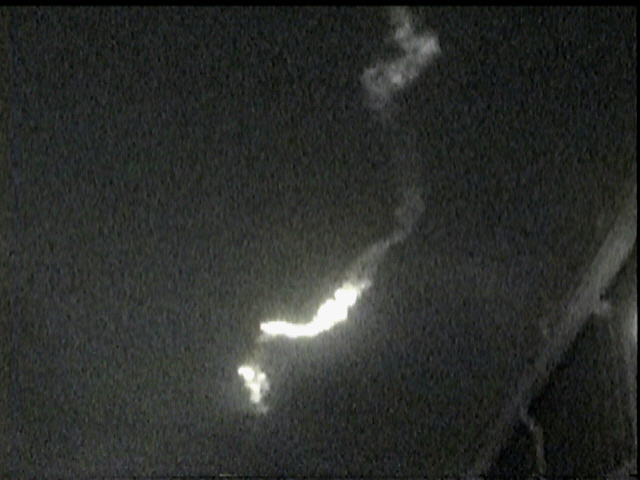
Below: Photo by Vince Fedoroff, Whitehorse Star. Appears to be taken at about the same time as the above image by Doug Davidge.
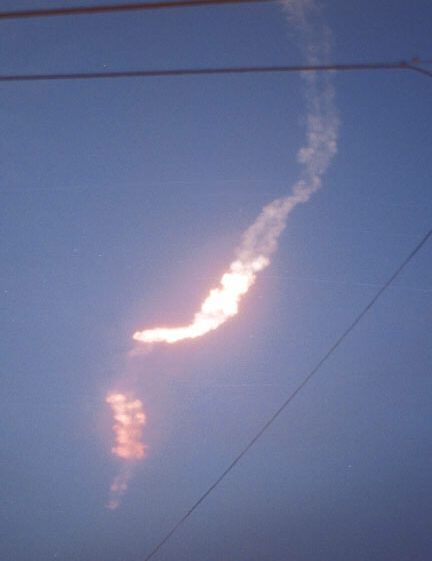
Below: Seven great photos by Ewald Lemke that were posted on the Atlin Realty web site! The first one was taken about one and a half minutes after the fireball passed through the sky.
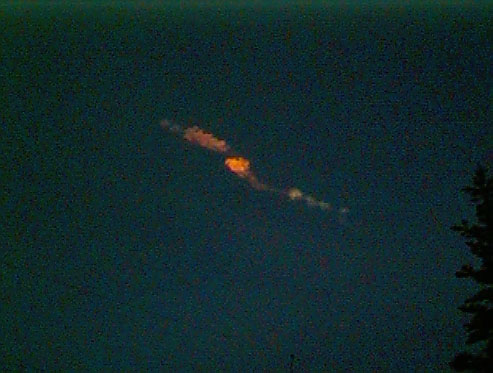
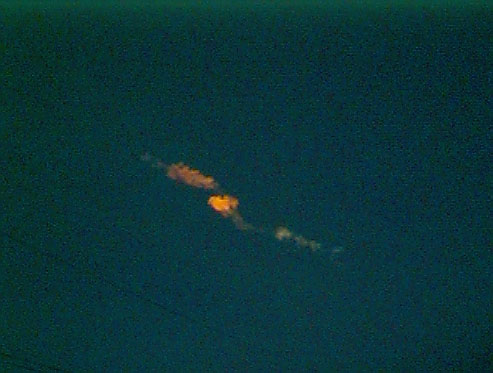
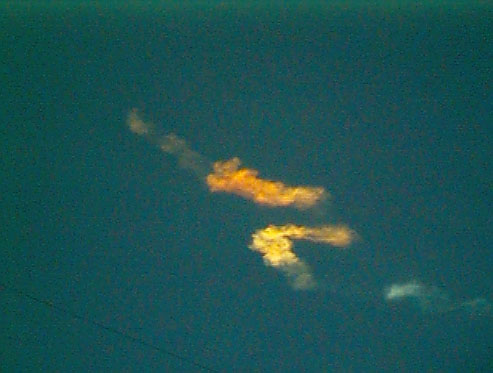
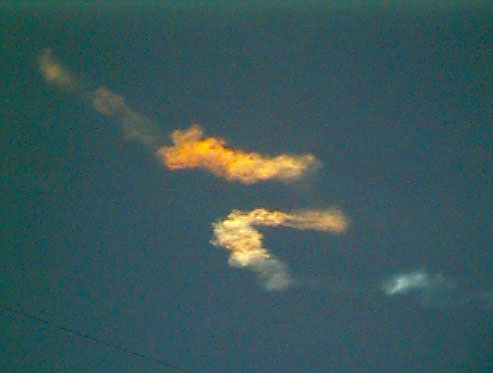
The one below was taken about 14 minutes after the first Atlin photo.
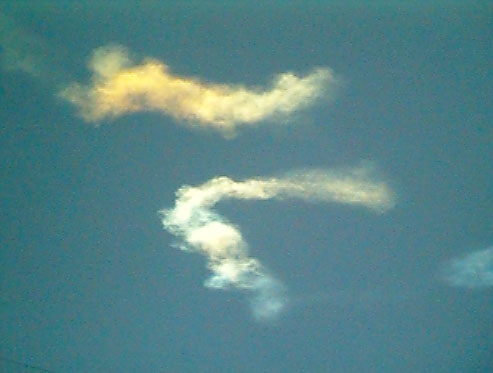
The one below was taken about 18 minutes after the flash in the sky was seen.
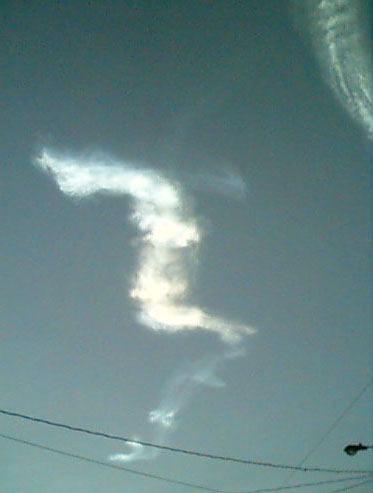
The one below was taken about 45 minutes after the first Atlin photo.
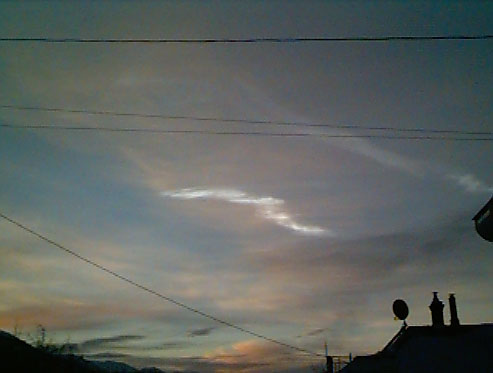
Below: A video still displayed on a local TV channel (WHTV, Whitehorse). Note how straight the contrail is in this image. It is therefore one of-if not the earliest image taken of the contrail.
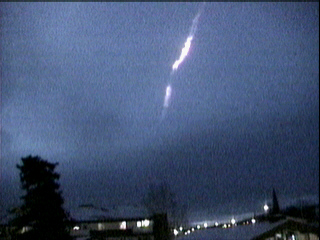
Below: Two photos of the contrail by Chris Savard taken from Porter Creek Subdivision, Whitehorse, YT.
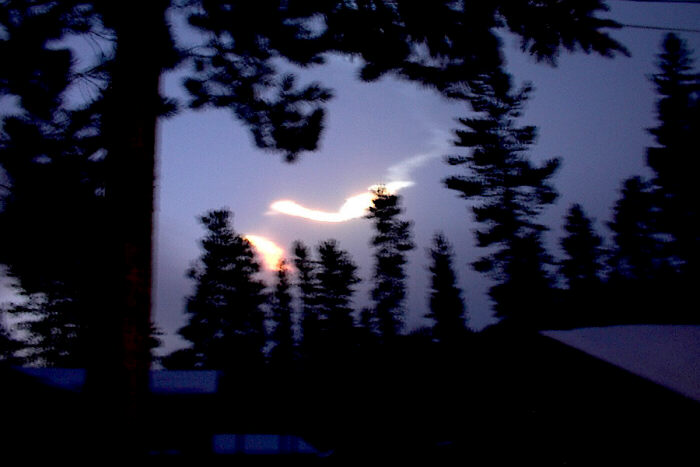
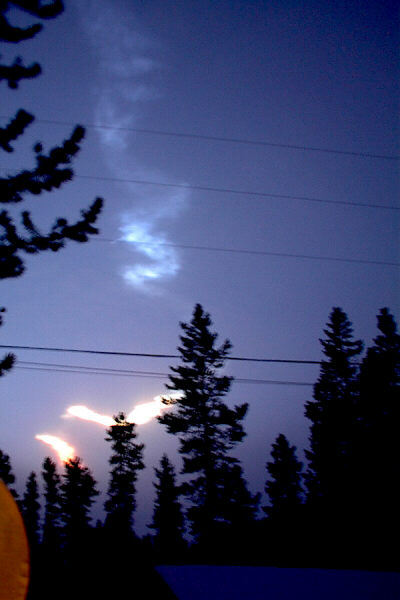
Below: An excellent drawing by Brian Beck who observed the fireball from his driveway in
Echo Valley Subdivision
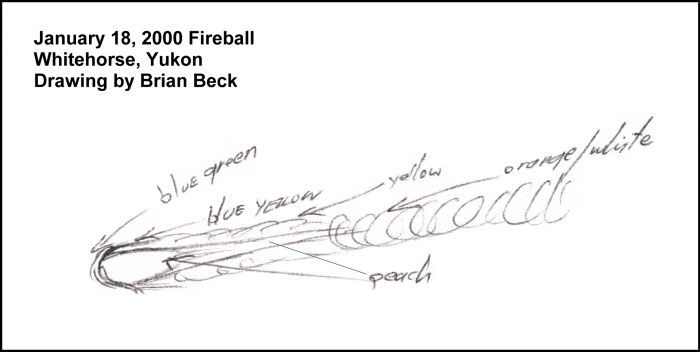

 RETURN TO "UFO Yukon Main Page"
RETURN TO "UFO Yukon Main Page"